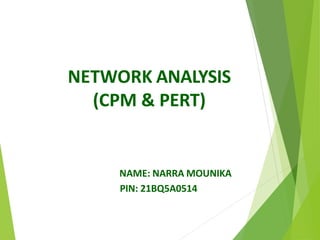EEM MID2.PPT.pptx
•Transferir como PPTX, PDF•
0 gostou•24 visualizações
NETWORK
Denunciar
Compartilhar
Denunciar
Compartilhar

Recomendados
Recomendados
Mais conteúdo relacionado
Semelhante a EEM MID2.PPT.pptx
Semelhante a EEM MID2.PPT.pptx (20)
project management-cpm and pert methods for managers

project management-cpm and pert methods for managers
Yagmur Bostanci47 Hackensack Street, East Rutherford, NJ929-22.docx

Yagmur Bostanci47 Hackensack Street, East Rutherford, NJ929-22.docx
Mais de mounikanarra3
Mais de mounikanarra3 (15)
sequencediagram-150302224029-conversion-gate01 (1).pdf

sequencediagram-150302224029-conversion-gate01 (1).pdf
Último
From customer value engagements to hands-on production support, our Services span across every stage of our customers digital transformation journey, to help ensure that every customer is successful in their adoption of our solutions.
• Implementation, Upgrade, Migration, and Maintenance Services
• On-Premises and On-Cloud
• COTS Training Services; On-Site and Virtual
• Software Support Services; Legacy and 3DEXPERIENCE
• Value Engagement & Blueprinting
• Specialized Consulting and Support Services
• Customized Training Services
• Automation and Configuration Services
• Technical Resource Augmentation Services
• Project Management
• Know-how Training (mentoring) and Resource AugmentationNavigating Complexity: The Role of Trusted Partners and VIAS3D in Dassault Sy...

Navigating Complexity: The Role of Trusted Partners and VIAS3D in Dassault Sy...Arindam Chakraborty, Ph.D., P.E. (CA, TX)
Process of Integration the Laser Scan Data into FEA Model and Level 3 Fitness-for-Service Assessment of Critical Assets in Refinery & Process IndustriesFEA Based Level 3 Assessment of Deformed Tanks with Fluid Induced Loads

FEA Based Level 3 Assessment of Deformed Tanks with Fluid Induced LoadsArindam Chakraborty, Ph.D., P.E. (CA, TX)
Último (20)
Cara Menggugurkan Sperma Yang Masuk Rahim Biyar Tidak Hamil

Cara Menggugurkan Sperma Yang Masuk Rahim Biyar Tidak Hamil
Navigating Complexity: The Role of Trusted Partners and VIAS3D in Dassault Sy...

Navigating Complexity: The Role of Trusted Partners and VIAS3D in Dassault Sy...
A CASE STUDY ON CERAMIC INDUSTRY OF BANGLADESH.pptx

A CASE STUDY ON CERAMIC INDUSTRY OF BANGLADESH.pptx
Tamil Call Girls Bhayandar WhatsApp +91-9930687706, Best Service

Tamil Call Girls Bhayandar WhatsApp +91-9930687706, Best Service
NO1 Top No1 Amil Baba In Azad Kashmir, Kashmir Black Magic Specialist Expert ...

NO1 Top No1 Amil Baba In Azad Kashmir, Kashmir Black Magic Specialist Expert ...
FEA Based Level 3 Assessment of Deformed Tanks with Fluid Induced Loads

FEA Based Level 3 Assessment of Deformed Tanks with Fluid Induced Loads
XXXXXXXXXXXXXXXXXXXXXXXXXXXXXXXXXXXXXXXXXXXXXXXXXXXX

XXXXXXXXXXXXXXXXXXXXXXXXXXXXXXXXXXXXXXXXXXXXXXXXXXXX
Orlando’s Arnold Palmer Hospital Layout Strategy-1.pptx

Orlando’s Arnold Palmer Hospital Layout Strategy-1.pptx
Unit 4_Part 1 CSE2001 Exception Handling and Function Template and Class Temp...

Unit 4_Part 1 CSE2001 Exception Handling and Function Template and Class Temp...
EEM MID2.PPT.pptx
- 1. NETWORK ANALYSIS (CPM & PERT) NAME: NARRA MOUNIKA PIN: 21BQ5A0514
- 2. NETWORKANALYSIS Network Analysis refers to a number of techniques for the planning and control of complex projects. The two most frequently used forms Of network planning are: 1. Programme Evaluation and ReviewT echnique 2. Critical Path Method (CPM)
- 3. WHAT ISANETWORK? A network is a graphical diagram consisting of certain configuration of “Arrows” () and “Nodes” () for showing the logical sequence of various tasks to be performed to achieve the project objective.
- 4. TERMS USED INANETWORK 1. Activity: An effort that is required to complete a part of the project. It is represented by “”. 2. Node: It represents the beginning or completion of an activity. It is represented by “”
- 5. RULES OF NETWORK CONSTRUCTION 1. Each defined activity is represented by one and only one arrow in the network. 2. Before an activity can be undertaken, all activities preceding it must be completed. 3. The arrows depicting various activities are indicative of logical procedure only. The length and bearing of the arrows are of no significance.
- 6. 4. The arrow direction indicates the general progression in time. Head events and Tail events. 5. When a number of activities terminate at one event, it indicates that no activity emanating from that event may start unless all activities terminating there have been completed. 6. Events are identified by numbers. 7. The activities are identified by the numbers of their starting and ending events or by alphabets.
- 7. 8. Anetwork should have only one initial and terminal node. Merge Event Burst Event A B C A B C
- 8. 10. Parallel activities between two events, without intervening events, are prohibited. When two or more parallel activities in a project have the same head and tail events, dummy activities are needed in constructing the network. Dummy activities do not consume time or resources. An efficient network contains a minimum number of dummy activities required to portray the correct precedence relationships. 11. Looping is not permitted in a network.
- 9. NETWORK SYMBOLS SYMBOL MEANING Activity Event Activity A must be completed before Activity B completed Activities A & B can occur concurrently, but both must be completed before activity C can begin Activities A & B must be completed before activities C & D can begin, but C can begin independently of D & vice versa
- 10. SAMPLE NETWORK
- 11. DUMMY ACTIVITY
- 12. CRITICAL PATH METHOD CPM aims at the determination of the time to complete a project and the important activities on which a manager shall focus attention.
- 13. PROCEDURE Consider all the paths in a project, beginning with the start event and stopping at the end event. For each path, calculate the time of execution. The path with the largest time is called the critical path and the activities along this path are called critical activities or bottleneck activities.
- 14. THANKING YOU